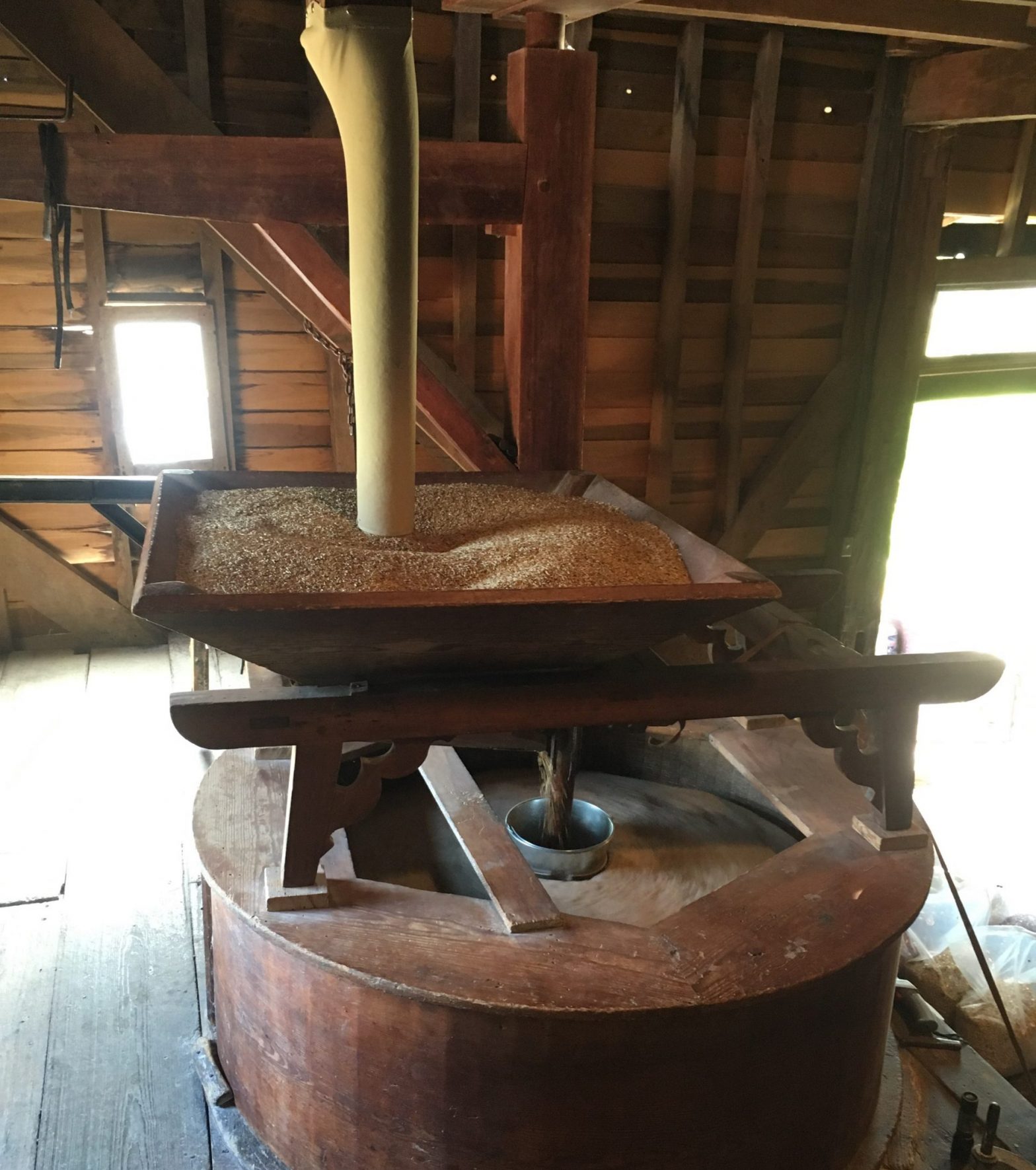Woodson’s Mill is alive. The green lawn is speckled with people in conversation. There’s smoke from a wood-fired pizza truck, and a number of vendor tables display local food and handcrafts. Rising above the gathering is the four-story, clapboard mill building that has stood there since the 1790s.
Inside the historic building, the sound of the crowd fades into the trickle of the Piney River, the zip of belts and pulleys, and the churning of the steel waterwheel. Underneath and at the heart of those sounds is the low rumble of the millstone.
On the first Sunday of every month, the grist mill opens its doors for the Mill Race Market, where patrons can buy local goods and see the process of making stone-ground flour. But even on less celebratory days, the millstone turns at the heart of a growing community, producing an industry of local grain that nourishes the culture of farmers, bakers, and foodies around it.
Millers Aaron Grigsby, Charlie Wade, and Ian Gamble brought new life to the mill when Deep Roots Milling moved its operation into the building in 2019, with the goal of making milled grains an accessible part of the local food movement. This access has been a glaring omission, considering grains are the foundation of a traditional diet, and wheat in particular is the most consumed food in the United States.
“Well, it is sort of the staff of life in the Western world and beyond it,” Grigsby points out.
The millers knew that bakers wanted to bake with whole grain to offer regionally, ecologically conscious food.
“We were pretty well aware that there would be a growing market for what we were doing, and that really the bottleneck was that it just wasn’t available,” Grigsby says. But the speed and extent of their growth was a surprise.
Deep Roots has won Good Food Awards for outstanding American craft food the last three years in a row, and the mill’s flour can be tasted in offerings at Belle, Althea Bread, Carpe Donut, Little Hat Creek Farm, MarieBette, Cou Cou Rachou, Albemarle Baking Company, Crustworthy Pizza, Slice Versa, Ambrosia, and Janey’s Bread. It’s also available retail from Stock Provisions, Foods of All Nations, and Greenwood Grocery. At the Ix farmer’s market, you can catch Deep Roots at a stand once a month ahead of the Mill Race Market, or find Tonoloway Farm making silver dollar pancakes with its flour.
As a co-founder of the Common Grain Alliance, Heather Coiner is interested in building the local grain economy as well as exploring it in her Little Hat Creek Farm bakery.
“What I like to do is I like to make familiar things with at least 50 percent stoneground, local flour,” Coiner says. “So, I make a white sandwich bread, I make a multigrain sourdough, I make rosemary crackers and graham crackers, chocolate chip cookies, and things that are really embedded in our culture.”
Her stock room is filled to the ceiling with sacks of flour. “I use Deep Roots flour in pretty much everything,” she says.
Her Danish rye bread was perfected through a working relationship with the millers, and being able to communicate the grades of flour she was after. There was some back and forth as they honed the ratios of cracked rye and finely ground powder for the mix. “Danish rye has three different grades of rye flour in it, and they have been really generous in working with me to provide those grades of flour that I need,” Coiner says.
Before Scott Shanesy opened the doors at Belle bakery, he knew he wanted to use local, stoneground flour from Deep Roots. “We got in here January 2020, and within the next year we were slowly working the recipes in,” Shanesy says. “Then this past year we made the big switch.”
Deep Roots flour is in their loaves, baguettes, English muffins, bagels, scones, and cookies. “I think everything now besides the donuts, cinnamon rolls, and the brioche,” says Shanesy. But the plan is to transition those items too.
For Shanesy’s hearth loaves with a crackly steamed crust, the process can stretch over three days to finish fermentation, but the rustic, sourdough loaves are the highlight of his bakery.
One of the reasons bakers like Shanesy want stoneground flour is that it has more of the whole grain in it—fiber and minerals from the bran, protein and fat from the germ. Commercial white flour is generally just the starch part of the grain, which makes it less nutritious, harder to digest, and less flavorful.
“My quickest telltale sign of quality is, do you need a drink with it?” Shanesy explains. “Are you salivating a lot? If the textures and aromas and the flavors aren’t right, you’re going to need help. But I’ve found that if the dough is fermented and broken down, and you achieve that right texture, you can just eat a half a loaf and not even think about it.”
